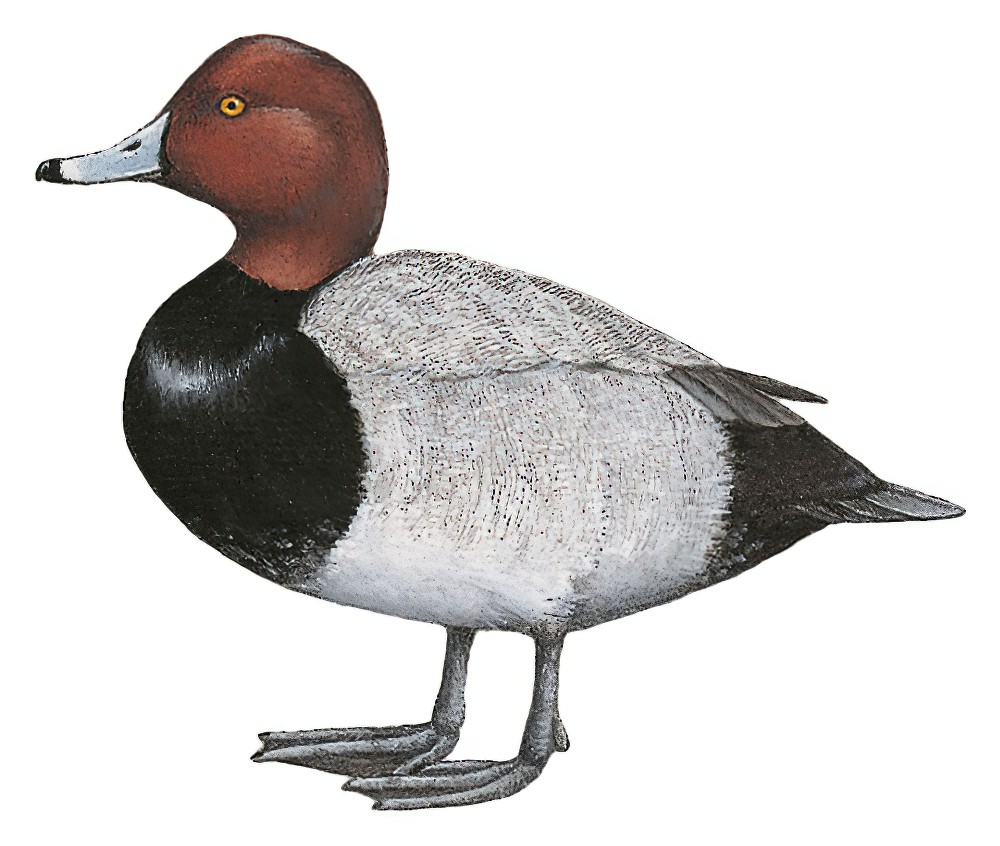Redhead / Aythya americana

Redhead
SCI Name:
Protonym: Fuligula americana Monogr.Anatidae p.155
Taxonomy: Anseriformes / Anatidae / Aythya
Taxonomy Code: redhea
Type Locality: North America.
Author: Eyton
Publish Year: 1838
IUCN Status: Least Concern
DEFINITIONS
AYTHYA
(Anatidae; Ϯ Greater Scaup A. marila) Gr. αιθυια aithuia unidentified seabird mentioned by Aristotle, Hesychius, and other authors. In modern times associated with a variety of seabirds, including a shearwater, a cormorant, a duck, and an auk (cf. Gr. myth. Thyr or Thyrie, mother of Cygnus, who was changed into a waterbird); "130. Aythya marila. — Anas marila Lin." (Boie 1822); "Aythya Boie, 1822, (before May), Tagebuch Reise Norwegen, p. 351. Type, by monotypy, Anas marila Linnaeus." (Johnsgard in Peters, 1979, I, ed. 2, p. 482).
Var. Aethyia, Aethyja, Aithyia, Aithya.
Synon. Aristonetta, Dyseonetta, Fuligula, Fulix, Glaucium, Hydrobates, Ilyonetta, Marila, Nettarion, Nyroca, Penelope, Perissonetta, Zeafulix.
americ / americana / americanum / americanus
Mod. L. Americanus American, of the Americas. Received opinion states that America was named after Amerigo Vespucci (d. 1512), a Florentine merchant who promoted and sailed on several voyages to the New World 1500-1502. The name was first used, of South America, by the cartographer Martin Waldseemüller in 1507. More recently Lloyd & Mitchinson 2009, have repeated the argument that the Americas were named after Richard Ameryk (d. 1503), a Welsh merchant and High Sheriff of Bristol who invested in John Cabot’s voyages of discovery 1497-1498. Coues 1882, refers to a Nicaraguan Indian name Americ for a local range of mountains, forgetting, however, that Nicaragua was not subdued by the conquistadores until 1522.
● North America; ex “Black-cheeked Eagle” of Latham 1781, and Pennant 1787 (?syn. Aquila chrysaetos).
● America (= eastern USA); ex Anas clangula of A. Wilson, 1814, and “Golden-Eye Duck” of Audubon 1836 (subsp. Bucephala clangula).
● Cayenne; ex “Martin-pescheur du Brésil” of Brisson 1760, “Martin-pecheur vert et blanc de Cayenne” of d’Aubenton 1765-1781, pl. 591, and “White and green Kingsfisher” of Latham 1782 (Chloroceryle).
● "52. CUCULUS. ... americanus. 7. C. cauda cuneiformi, corpore supra cinereo: subtus albo, maxilla inferiore lutea. Cuculus carolinianus. Catesb. car. 9. t. 9. Habitat in Carolina." (Linnaeus 1758) (Coccyzus). This name is the eighth toponym in avian nomenclature.
● North America; ex “Cinereous Coot” of Latham 1785 (Fulica).
● "76. ARDEA. ... americana. 5. A. vertice temporibusque nudis papillosis, fronte nucha remigibusque primariis nigris, corpore albo. Grus americana alba. Catesb. carol. I. p. 75. t. 75. Edw. av. 132. t. 132. Habitat in America septentrionali. Caput subtus ad maxillam inferiorem rubrum est." (Linnaeus 1758) (Grus).
● Erroneous TL. North America (?= Cayenne); ex “Black-chested Eagle” of Pennant 1766 (?syn. Harpia harpyja).
● Cayenne; ex “Aigle d’Amérique” of d’Aubenton 1765-1781, pl. 417 (Ibycter).
● Louisiana; ex “Pie-grièche de la Louisiane” of d’Aubenton 1765-1781, pl. 397 (syn. Lanius ludovicianus).
● Cayenne; ex “Merula indica pectore cinnabarino” or “Jacapu” of Marcgrave 1648, “Red-breasted Indian Blackbird” of Willughby 1676, “Troupiale de Cayenne” of d’Aubenton 1765-1781, pl. 236, fig. 2, and de Buffon 1770-1783, “Mocking bird of Guiana” of Bancroft 1769, and “Red-breasted Oriole” of Latham 1782 (syn. Leistes militaris).
● Paraguay; ex “Tordo degollado tercero” of de Azara 1802-1805, no. 70 (syn. Leistes superciliaris).
● Louisiana and New York; ex “Canard Jensen de la Louisiane” of de Buffon 1770-1783, and “American Wigeon” of Pennant 1785, and Latham 1785 (Mareca).
● North America; ex Mergus merganser A. Wilson, 1814 (subsp. Mergus merganser).
● Erroneous inferred TL. America (= Île de France (= Mauritius) = Philippines); ex “Guespier de l’Île de France” and “Petit Guespier des Philippines” of Brisson 1760 (Merops).
● "74. MYCTERIA. ... americana. 1. MYCTERIA. Jabiru-guacu. Marcgr. bras. 201. Pis. bras. 87. Raj. av. 96. Will. orn. 202. t. 47. f. 2. 4. Habitat in America calidiore. Magnitudo Ciconiæ, alba, remigibus rectricibusque nigro-purpurascentibus. Conf. Grew. mus. t. 5. f. 1." (Linnaeus 1758) (Mycteria).
● Louisiana; ex “Gallinula martinica” of Ord 1825 (syn. Porphyrula martinica).
● North America; ex “Avosetta” of Dampier 1697, and “American Avoset” of Pennant 1785, and Latham 1785 (Recurvirostra).
● "86. STRUTHIO. ... americanus. 3. S. digito postico rotundato mutico. Struthio Camelus americanus. Raj. av. 36. Nhanduguacu brasiliensibus. Marcgr. bras. 190. Pis. bras. 84. Habitat in America australi." (Linnaeus 1758) (Rhea).
● South Carolina; ex “Parus Fringillago. Finch-Creeper” of Catesby 1731 (Setophaga).
● America (TL erroneously given as Europe); ex “Yellow-backed Warbler” of Latham 1783 (syn. Setophaga americana).
● "102. CAPRIMULGUS. ... americanus. 2. C. narium tubulis eminentibus. Caprimulgus s. Noctua sylvatica jamaicensis. Sloan. jam. 2. p. 298. t. 255. f. 1. Raj. av. 180. Hirundo major subfusca miscella, macula alba sphærica in utraque ala. Brown. jam. 467. Habitat in America calidiore." (Linnaeus 1758). This is the last avian name in the epochal tenth edition of Linnaeus (‡Siphonorhis).
● New York; ex “Black-throated Bunting” of Pennant 1785 (Spiza).
● Some part of America (= Cayenne); ex “Black-breasted Grosbeak” of Latham 1783 (Sporophila).
● Virginia (= Pennsylvania); ex “Urogallus minor. Cocq de bois d’Amérique”of Catesby 1731, and “Attagen americana” of Brisson 1760 (syn. Tympanuchus cupido).
● Río de La Plata; ex “Hirondelle à croupion roux et queue carrée” of de Buffon 1770-1783, and “Rufous-rumped Swallow” of Latham 1782 (unident.).
UPPERCASE: current genus
Uppercase first letter: generic synonym
● and ● See: generic homonyms
lowercase: species and subspecies
●: early names, variants, mispellings
‡: extinct
†: type species
Gr.: ancient Greek
L.: Latin
<: derived from
syn: synonym of
/: separates historical and modern geographic names
ex: based on
TL: type locality
OD: original diagnosis (genus) or original description (species)












